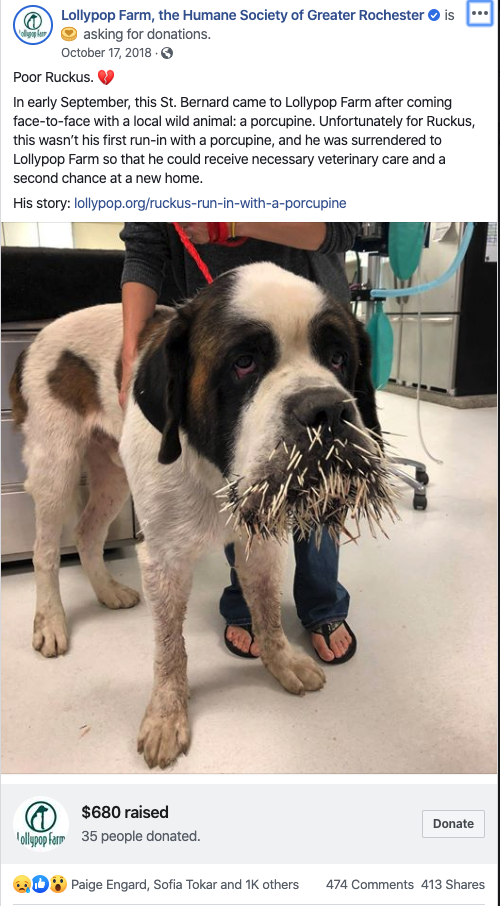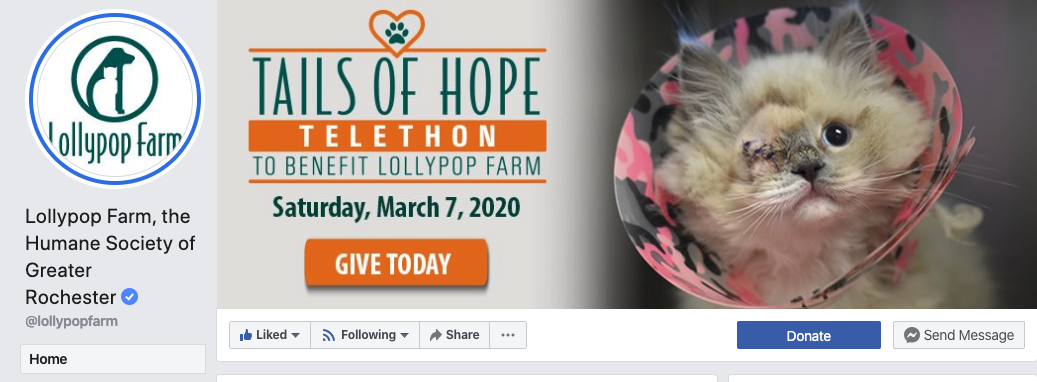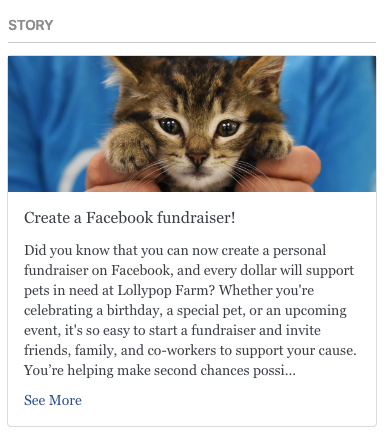A Conversation with Paige Engard (Doerner): Tips for Facebook Fundraising
/Meet Paige Engard (Doerner) - Communications Coordinator & Facebook fundraising expert
This is the second post in the “A Conversation With” series, where I interview talented folks about their areas of expertise, whether that’s social media, marketing, communications, or public relations. You can read past entries in the series here.
This month, I interviewed Paige Engard (Doerner), an experienced social media professional. She has developed and implemented an effective Facebook fundraising strategy for Lollypop Farm. I hope you enjoy her tips and best practices!
Tell me about your role at Lollypop Farm and what you do day-to-day.
I’m the Communications Coordinator at Lollypop Farm; I’m most known for my role doing social media for the organization, but I do a whole assortment of other things behind the scenes. I create and publish all the social media content, but I also do blog writing, graphic design, posters, flyers, planning adoption programs, and coordination of internal and external communications. Since it’s a nonprofit, I wear a lot of hats!
How long have you been doing Facebook fundraising for Lollypop Farm?
Lollypop Farm has been doing traditional fundraising forever; we first integrated charitable tools on Facebook about a year and a half ago. I got some pushback at first, because it was new and scary, plus it’s not what traditional fundraisers want to see when we get donor data back. It was a big leap to take, but the benefits hugely outweigh the costs.
What is it about the donor data Facebook delivers that frustrates fundraisers?
While the data that we get back from Facebook donations is not as comprehensive as with traditional methods of giving, it's always getting better, and we consistently receive more and more valuable information about supporters. The information we receive is based on what people are willing to put in depending on their privacy concerns. Sometimes we get names and sometimes email addresses too. It depends.
Traditional fundraisers really want those names and emails so we can steward those people. You absolutely can continue to steward those donors! It’s an extra bonus that they’ve already interacted with our content in a positive way. And if someone gives anonymously, it’s likely they’ll continue to do so in whatever way they can manage.
How did you handle the pushback you received?
I explained that when it comes to younger donors, you have to meet them where they’re most comfortable. They may feel more comfortable donating on Facebook. Part of it is ease, part of it is the ability to share with friends- that’s a social currency boost for people. We’ve seen a huge amount of new donors who are entirely new to the organization.
I know a lot of folks fear that Facebook takes a cut of fundraisers. Can you dispel that myth?
Facebook does not take a cut (at least not right now). We receive 100% of donations which come in through Facebook, which is fantastic.
What was the learning curve like when you first got started?
It was a bit of a struggle to get set up on the backend and get all the financial pieces in line, but once that’s done, it’s a relatively simple way for nonprofits to activate people online. Especially if you’re already familiar with the basics of crowdfunding strategies.
How frequently do you include a donate button on your Facebook posts? How do you prevent fundraising fatigue among your audience?
You wouldn’t hit someone up with an email asking for money every day. But when it comes to nonprofits’ missions, the need never goes away. I like to create a quarterly plan, where I plot out different themes of giving for the whole year. For example, we focus on Barktoberfest in the fall and holiday giving for year-end.
You can plan on adding a donate button to a post once/week, but should also be ready to jump on a really good story when it comes along, all the while making sure to not oversaturate people. You have to be adaptable.
What makes a good Facebook fundraiser? Are there certain storytelling elements that help it be more successful?
One thing I’ve learned through my experience at Lollypop Farm is the importance of expressing need through digital storytelling. It’s the best way to encourage people to give. You tell a story as it’s happening in real time, using images and text to show the great need. An example I use in presentations is Ruckus, a dog who had a run-in with a porcupine. Photos of Ruckus with porcupine quills stuck in him showcased the immediate need. It lets people step in to fill the gap and be the hero of the story. Helping your audience recognize that they can be an active part of the story as it’s happening only stands to benefit your organization by bringing in more support.
A lot of our strategy involves hitting people in multiple places. A campaign can incorporate email, direct mail, and social media. The social media aspect lets people give where they’re comfortable.
A fundraiser for Ruckus after his porcupine run-in
What kind of copy do you use for fundraising posts?
I like to use the donate button passively sometimes. We’ll have a pet in need, and I’ll explicitly say, “please donate now.” Other times, I’ll tell a great story with a compelling photo and not include a specific ask, but still include a donate button on the post. We’re not pressuring anyone to do anything. It’s just passive versus active asking, and the reality is there’s always need.
Lollypop Farm’s cover photo includes a visual call to action to give today. Paige leaves the donate button up year-round.
Have you experimented with having different CTA buttons on your Facebook page? Do you leave donate up year-round, or change it periodically?
I didn’t use to leave it up all the time, but I do now. Part of the reason for that is the tremendous success of themed fundraisers, whether it’s for a birthday or Day of Giving. I saw a lot pop up on Day of Giving this year, which was nice. We use different parts of our Facebook page to prompt that. The about section of our Facebook page explains how to set up your own Facebook fundraiser, and our cover photo has a donate graphic on it. When someone creates their own fundraiser, it automatically pulls in our cover photo with the donate prominently displayed in the middle of it.
In that about section, I also give an option with a link that will send them back to the donate form on the website. I like to give people options.
With these peer-to-peer fundraisers, it’s all about the person leading the charge. It’s an awesome way to capture new donors. Because they’re giving through that person, they may not be our traditional supporters, but now they’re engaged in our mission.
Fundraiser information under Story in the About section of the Lollypop Farm Facebook page
Can you tell me about a record-breaking fundraising campaign?
Barktoberfest is our annual peer-to-peer fundraising event; people form teams, get donations from friends and family, and walk for pets in need. We encouraged people to create Facebook fundraisers for their teams and saw a huge amount come through. This gave us the opportunity to create tools for fundraisers. We created a digital toolkit and people seemed to utilize it. It included sample text, graphics to use, and best practices for Facebook fundraising. Things like thank your donors, utilize copy from our Facebook page, reuse content from our blog. This model worked and we’re continuing to create toolkits for upcoming events like our telethon in March.
If you’re asking your digital audience to fundraise for you, it’s in your best interest to help them do well. It benefits the cause. The toolkit is available right on the website, there’s no need to request it or anything.
Have you ever led a Facebook fundraising campaign that flopped? What did you learn?
All the time! You have to learn somehow. This is so new. I utilize the donate button on Facebook all the time. Sometimes it works really well, and sometimes it doesn’t. If it flops, it flops. There’s nothing to be lost by telling a compelling story and adding a donate button.
Have you experimented with the donate button on Instagram Stories? How is that going?
It’s still new, so we have to teach our audience how to use it. I screenshotted the process of how it works, how to add the button to your story, and shared that. I’m feeding people best practices. The process of donating on Instagram is not as seamless as it is on Facebook. The extra steps are where you tend to lose people.
Instagram now allows you to add a donate button on your profile as well as in Stories. So far, the most success we’ve had was when we rescued cats from an eviction situation, shared the story in real time on Instagram Stories, and used the donate sticker.
Lollypop Farm has integrated a donate button into their Instagram profile.
What resources would you recommend for continued learning on this topic?
@JuliaCSocial on Twitter
Nonprofit Social Media Storytelling - Support & Ideas Facebook group
Want more great social media content? Sign up for my unboring email newsletter!







